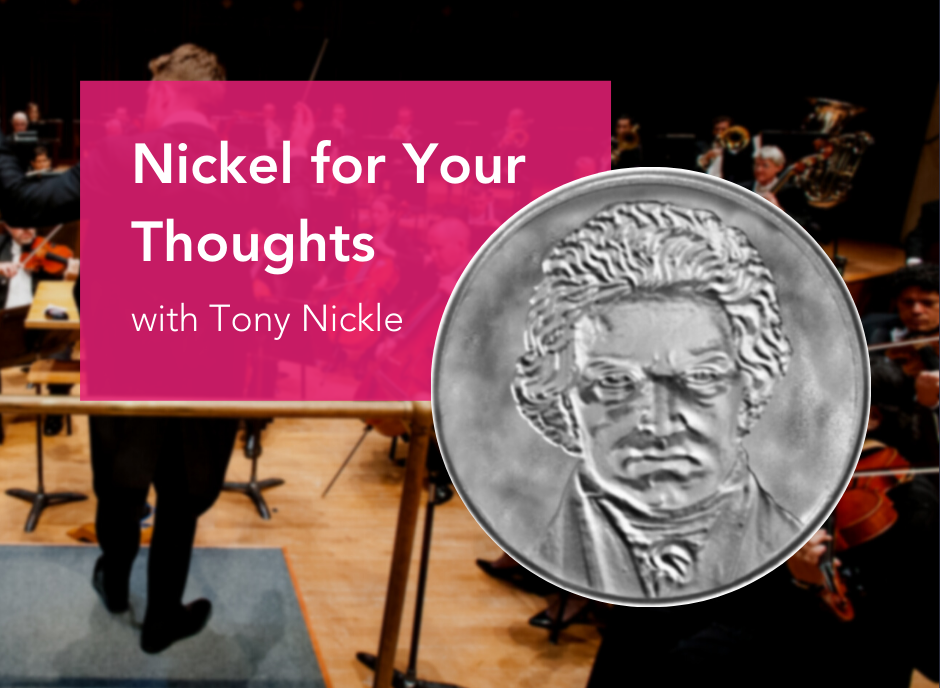In his own words, Vice President & Artistic Administrator Tony Nickle shares what he believes to be the high points of the program, but with a little edge and humor for good measure.
Following an exciting season opener in which we featured the fantastic Daniel Hsu performing on our new Steinway, we turn the spotlight this week onto our wonderful orchestra musicians. This is a program that features several of them individually in a variety of ways. The first two pieces on the program manage this through the musical conversation between a small group of instruments and the rest of the ensemble; the final piece gives several instruments their solo time to shine through a set of variations on a theme.
By the time Johann Sebastian Bach was born in 1685 the Baroque Era was already about 85 – 105 years old, depending on who you ask. Italian composers played a massive role in these initial decades, with some of the most recognizable names being Claudio Monteverdi (essentially the granddad of opera), Alessandro Stradella, Arcangelo Corelli, Alessandro and Domenico Scarlatti, and Antonio Vivaldi. Some of these and several others were instrumental in the development and codifying of concertos. These aren’t the concertos we think of when we hear Tchaikovsky, Rachmaninoff or even Beethoven, but they do share one thing in common: they provided a solo or small group of instruments the opportunity to play more virtuosically than instruments typically would in a full ensemble. A concerto that featured a small group of instruments alongside a fuller ensemble became known as a concerto grosso, where the large ensemble typically introduced the main themes, subjects or motives, and would bring them back together in part or in whole throughout a movement. In between these structural pillars of musical ideas (ripieno) the smaller group (concertino) would play more stylistically improvisatory material intended to show off these musicians’ abilities. The Baroque Era grew into a period that emphasized creating space in compositions for soloists or small groups to demonstrate musical acrobatics and fireworks (think da capo arias in Baroque opera).
In 1721 Bach presented a set of six concerti grossi to the Margrave of Brandenburg, a state that today lies in northeastern Germany and western Poland. Unfortunately, due to a lack of public support for the arts in that state the Margrave couldn’t field an orchestra capable of performing the works, so they probably weren’t premiered for several decades. These six concertos took the form to new heights, featuring quite innovative combinations of instruments in the concertino, including the first inkling of a keyboard concerto in the fifth concerto in which Bach gave the harpsichord an extended solo; up until that point the harpsichord functioned solely as harmonic and rhythmic support in larger ensembles, known as the continuo. The Brandenburg Concerto No. 1 showcases two solo horns, three oboes, a bassoon and a solo violin in the concertino. In the first movement Bach plays several of these off of each other as a conversation within the smaller concertino group. The second movement highlights the oboe, moving freely above the ensemble in familiar Baroque fashion. The solo violin is the focus à la Vivaldi in the third movement. The final movement is a series of dances that harken back to the Renaissance, each focusing on combinations of concertino instruments.
Dumbarton Oaks is Stravinsky’s homage to Bach’s Brandenburg Concertos, written during his Neoclassical period during which he looked back to the Baroque and Classical Eras. Commissioned by the owners of the eponymous Washington D.C. estate for their wedding anniversary. Like the Brandenburgs, Stravinsky weaves conversation between a string orchestra and a smaller concertino made up of winds and horns. The bookend fast movements bubble with the energetic and rhythmic motor of the Baroque Era, combined with Stravinsky’s own flavor of Americana. I always find the beginning’s open intervals, angular melodic lines and spotlight on the winds to be evocative of the first allegro music in Copland’s Appalachian Spring, though Dumbarton Oaks was written five years earlier so maybe prescient, or foreshadowing is a better word. I strongly suggest finding out for yourself by coming to this weekend’s concert as well as our program featuring Appalachian Spring in March!
Courtney and the Symphony wrap up the concert with Alberto Ginastera’s Concert Variations. In contrast to the first two pieces, it isn’t structured with alternating full and small ensemble/solo instruments in quite the same way, though the dialogue remains at several points throughout. A lone cello and harp open the piece, announcing the theme. Each subsequent variation features a different solo or small group of instruments; at times the full ensemble is tacit, others supportive, and sometimes conversational. With the largest orchestra on the program, this piece gives us the greatest variety of color, and as a theme and variations provides substantial tempo variations throughout. It’s a nice counterpoint to the driving rhythms of the first two pieces and a thrilling finale to the program.
I hope to see you Friday or Saturday night for one of the most unique programs of our entire season!
Learn more about the Bach to America performances here.
By Tony Nickle, Vice President & Artistic Administrator


